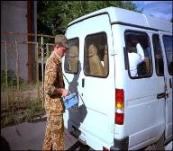
Nuclear Nonproliferation
One of the gravest threats the United States and the international community face is the possibility that terrorists or rogue nations will acquire nuclear weapons or other weapons of mass destruction (WMD). Their continued pursuit of these weapons, along with related technologies, equipment, and expertise, increases the urgency of NNSA's efforts to:
- Detect nuclear and radiological materials, and WMD-related equipment;
- Secure vulnerable nuclear weapons and weapons-usable nuclear and radiological materials;
- Dispose of surplus weapons-usable nuclear and radiological materials.
NNSA, through its Office of Defense Nuclear Nonproliferation, works closely with a wide range of international partners, key U.S. federal agencies, the U.S. national laboratories, and the private sector to detect, secure, and dispose of dangerous nuclear and radiological material, and related WMD technology and expertise.
Detect
NNSA is taking steps to deter and detect illicit transfers of weapons-usable nuclear and radiological materials and equipment, prevent the spread of sensitive nuclear weapons technology and develop cutting-edge nuclear detection technologies.
 NNSA’s work enhances the capabilities of our foreign partners to interdict illicit trafficking of nuclear and radiological materials by deploying radiation detection systems at high-risk border crossings, airports and seaports. NNSA is particularly concerned that terrorists could use the global maritime shipping network to smuggle nuclear and radiological materials or warheads. By installing radiation detection systems at major seaports throughout the world, NNSA strengthens the detection and interdiction capabilities of our partner countries. NNSA’s work enhances the capabilities of our foreign partners to interdict illicit trafficking of nuclear and radiological materials by deploying radiation detection systems at high-risk border crossings, airports and seaports. NNSA is particularly concerned that terrorists could use the global maritime shipping network to smuggle nuclear and radiological materials or warheads. By installing radiation detection systems at major seaports throughout the world, NNSA strengthens the detection and interdiction capabilities of our partner countries.
NNSA also provides export control and WMD-awareness training to both domestic and foreign export control and customs officials, which strengthens the ability to deter and detect WMD-related technology transfers. The tools that NNSA provides to partnering countries help prepare officials to recognize and identify dangerous materials and technologies that could be diverted for use against the United States and its allies.
NNSA is the principal federal sponsor of long-term nuclear nonproliferation-related research and development. These investments focus on leading-edge, high-risk/high-payoff, basic and applied research, including testing and evaluation. NNSA’s efforts lead to improvements in nuclear detection and characterization systems. Additionally, in the area of nuclear detonation detection, NNSA provides operational hardware and software for national security systems. These efforts provide the technical base for national and homeland security agencies to meet their nonproliferation, counterproliferation and counterterrorism responsibilities.
Secure
Preventing terrorist access to weapons of mass destruction remains one of NNSA’s highest priorities. NNSA helps to keep the world’s most dangerous materials out of the hands of the world’s most dangerous people by securing nuclear weapons and nuclear and radiological materials at their source, and improving security practices around the world.
 Since 1991, NNSA’s weapons and materials security programs have focused principally on Russia, due to the concentration of poorly secured material within the Russian Federation. NNSA has made great progress cooperating with Russia to strengthen protection, control, and accounting of its nuclear weapons and materials. Although these security upgrade efforts are largely drawing to a close after over a decade of work, NNSA will continue work at sites recently added to the program, and will continue to work cooperatively with Russia to ensure the long-term sustainability of the systems and procedures already in place. Since 1991, NNSA’s weapons and materials security programs have focused principally on Russia, due to the concentration of poorly secured material within the Russian Federation. NNSA has made great progress cooperating with Russia to strengthen protection, control, and accounting of its nuclear weapons and materials. Although these security upgrade efforts are largely drawing to a close after over a decade of work, NNSA will continue work at sites recently added to the program, and will continue to work cooperatively with Russia to ensure the long-term sustainability of the systems and procedures already in place.
However, not all nuclear material is located in Russia. NNSA is working with other partners to secure weapons-usable nuclear materials in additional parts of the world and to strengthen security at civil nuclear and radiological facilities. One area of particular concern is research reactors, which often use highly enriched uranium (HEU) fuel otherwise suitable for bombs. To mitigate this threat, NNSA converts research reactors around the world from HEU to low enriched uranium (LEU) fuel and returns HEU to the country of origin, either the U.S. or Russia. Further, NNSA is also working to remove or secure significant quantities of excess, vulnerable radiological materials that exist worldwide and could be used to make a dirty bomb.
Additional nuclear security challenges concern the effectiveness and credibility of international nuclear safeguards and export controls. Growing nuclear energy demand and concerns over the spread of sensitive nuclear technologies place increasing strain on international safeguards. NNSA is working to update international nuclear safety standards to reflect present day challenges and to ensure sustained U.S. leadership and investment in nuclear nonproliferation technologies and expertise.
Dispose
An integral part of NNSA’s strategy to meet nonproliferation challenges has been to eliminate dangerous material altogether by encouraging other states to stop producing it, and to dispose of excess nuclear and radiological material.
 For example, Russia still produces weapons-grade plutonium – not because it needs it for weapons, but because plutonium-producing nuclear reactors provide the sole source of heat and electricity to local communities. NNSA is helping to replace that heat and electricity generation capacity, thereby eliminating Russia’s plutonium production. For example, Russia still produces weapons-grade plutonium – not because it needs it for weapons, but because plutonium-producing nuclear reactors provide the sole source of heat and electricity to local communities. NNSA is helping to replace that heat and electricity generation capacity, thereby eliminating Russia’s plutonium production.
NNSA is also disposing of substantial quantities of surplus weapons-grade HEU that results from the dismantlement of thousands of U.S. warheads, and is working to reduce the large stocks of excess HEU that are now being returned to the U.S. and Russia. Once weapons-usable HEU is downblended, or converted, to low enriched uranium, it can be used for fuel in commercial reactors and becomes unsuitable for use in nuclear weapons.
In addition to HEU disposition efforts, NNSA is overseeing efforts to dispose of U.S. and Russian weapons-grade plutonium. The weapons-grade plutonium will be converted to mixed-oxide (MOX) fuel which, once irradiated in commercial reactors, will no longer be suitable for use in nuclear weapons.
|
 |